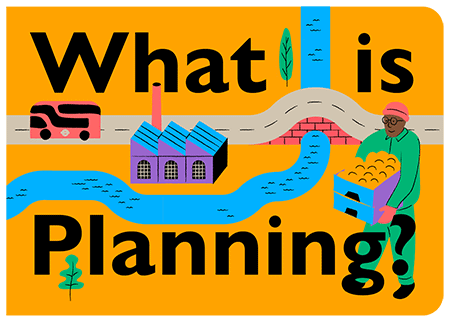Understanding planning and planning policy
The planning system can be complex and dominated with jargon. We want to break down these barriers and make planning and its processes easier to understand.
We want to put people first when producing our policy and encourage early engagement with the community.
We’ve created an illustrated booklet to help explain how planning works, why it’s needed, how policies are made and who is involved.
Purpose of planning
The purpose of planning is to guide and regulate the way land is used and developed.
Planning policy guides decision-making at local and national levels. It aims to balance different needs and interests in places. Policy also helps meet the needs of the borough such as for new housing, commercial development, or infrastructure.
The Local Plan
The Local Plan is the main planning document a Local Authority uses to set out their aspirations for the area.
It is influenced by community engagement and includes a list of locations or areas where development could happen and what could happen there.
The policies apply whenever someone applies for planning permission. Mostly this applies to new development projects. However, major refurbishments of existing buildings do require planning permission; as well as changes of use of buildings and land, for example turning a shop into a home.
We also create policies that aim to improve open spaces and make sure new developments are integrated within existing communities and neighbourhoods.
Once a plan is approved, it is used to help decide the outcome of planning applications for the next five to ten years. It also helps landowners and developers understand the council’s priorities.
Local Plan priorities
We have three main priorities when developing polices for the Local Plan.
Placemaking

Values good quality design and protects the identity and heritage of our places. It also manages public transport and connection, provides inclusive and accessible open spaces and supports biodiversity and climate change management.
Inclusive growth

Supports an active local economy to deliver work and opportunities. It also provides sustainable housing as part of responsible development to meet local need, including mixed-use development.
People first

Improves choice for transport, leisure and work, improving and maximising health and wellbeing. It also supports active travel (walking and cycling) and ensures day to day facilities are accessible.
Factors that influence policy
Lots of considerations shape how we produce forward-thinking policies, such as:
- Local need
- Our community
- Climate emergency
- Health and wellbeing
- Flooding prevention
- Durability and long-term thinking
- Transport and connection
- Land value
- Political decisions
- Protecting and enhancing heritage
- Finding the balance
Not every new development will meet all the policy requirements. Sometimes factors like higher quantities of affordable housing or delivery of a new school are prioritised. Each decision is made on an individual basis, depending on the context and level of need in that area.
How to get involved
We all have different values and priorities, which is why it is important to hear from many different people when policies that shape all our futures are being produced. Policies do not solve everything, but they are influential in planning decisions. Everyone’s voices need to be heard.
New and large-scale development projects can take as long as ten to fifteen years or more to go from concept to completion. The decisions made now will be applied in the future. Getting involved at an early stage is a good opportunity to have influence in your area.
Your feedback
We want to create a Local Plan that reflects you.
Not everyone uses shared spaces like parks and high streets in the same way – this is why we need feedback from a diverse group of people.
- Spread the word - tell friends, family and neighbours to get involved too
- Speak to your local councillor
- Follow us on social media: Twitter, Instagram, Tik Tok, Next Door
- Look out for new consultations or opportunities to have your say
- Check your copy of Brightside magazine
- Sign up for the newsletter

